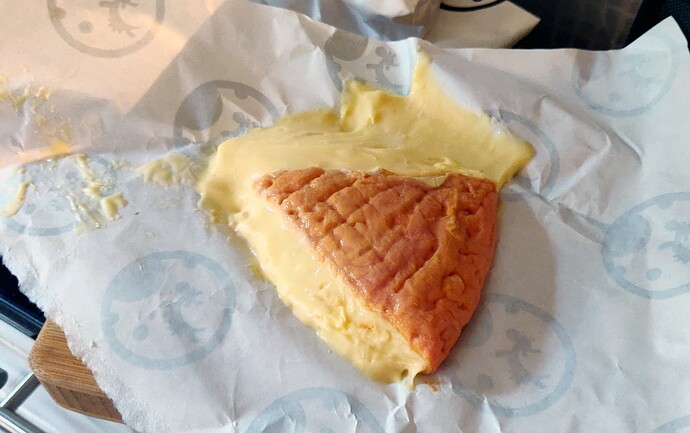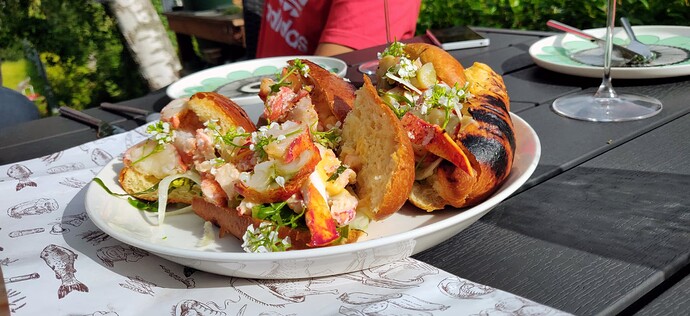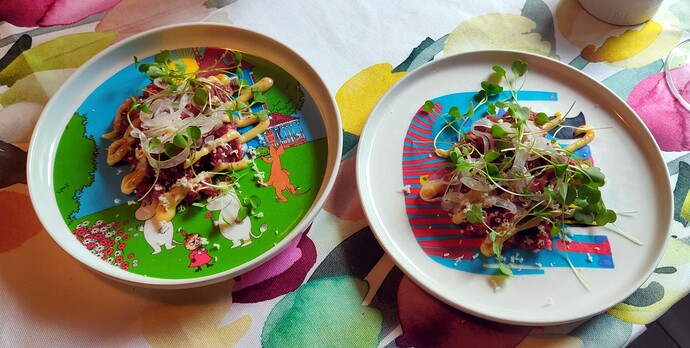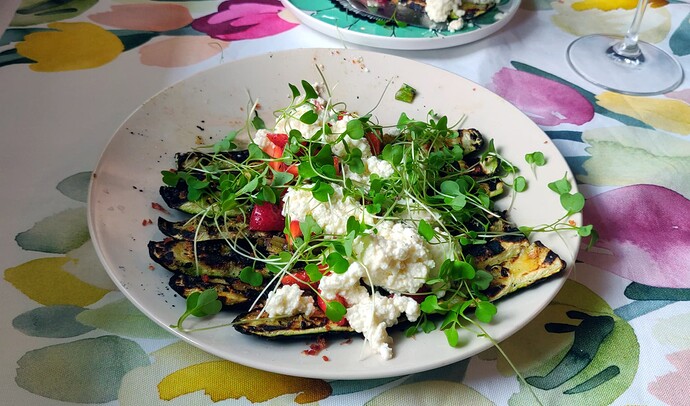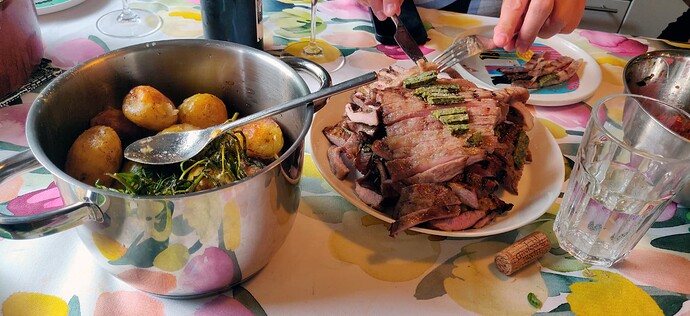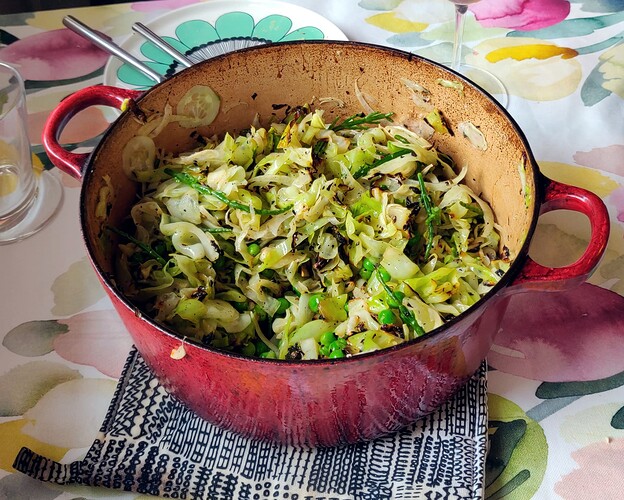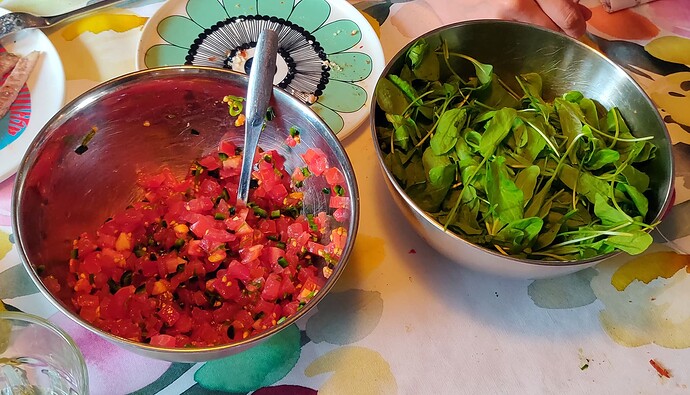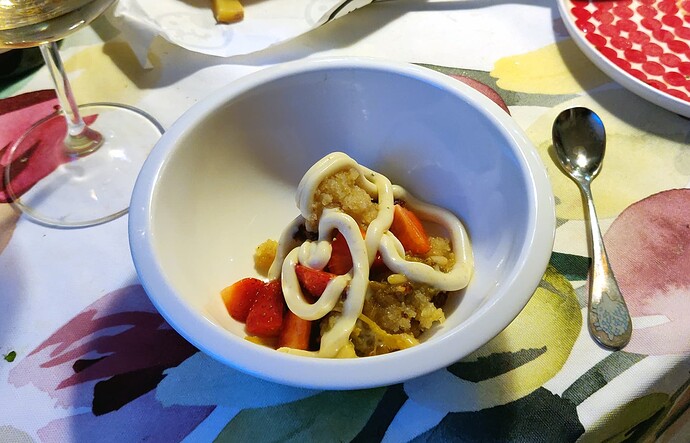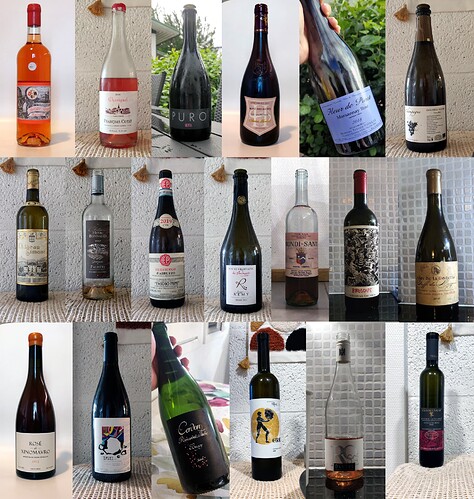So, this was the follow-up to our original Brosé Bronanza with the Brochachos evening we had on a lovely summer’s day before the COVID pandemic - and unlike me, @IlkkaL did pretty great job at reporting on this part 2 on a timely fashion.
Anyways, better late than never. As I’m now sorting through my tasting notes from last July, this event popped on my table only now, but hopefully nobody will mind the belated notes. It’s not as if I’m reporting from an en primeur tasting or anything.
Unfortunately we didn’t get to enjoy as great weather this time as before - I actually arrived at @Mikko_R’s place completely drenched, all the way down to my underwear, because halfway through the bike trip from my place to Mikko’s I was assaulted by a freak flash flood from the sky or something similar. At some point we did have some opportunities to chill and grill outside on Mikko’s porch, but the intermittent summer rains eventually forced us to retreat back inside.
Anyways, the idea of this Bronanza has been from the beginning that we polish off bunch of rosé wines that are not any wimpy pink wines, but instead as impressive, vinous and complex rosé wines as they come. And eat mounds of food. And once we are either out of food or we can’t stuff any more food down our throats, we retreat to play Mortal Kombat 2.
(I want to make it clear here that even if Ilkka is very skilled combatant in Mortal Kombat and truly a formidable adversary, he still didn’t manage to beat me in the game. Not this time nor on any other occasion we’ve played the game. I still remain the undefeated champion of our super serious Mortal Kombat group.)
Anyways, here is everything we ate. Following the next few days after the tasting I felt like I didn’t have need to eat anything, so I guess we must have had more than enough to eat.
And here are the wines. As exceptions to the brosé rule, we had two non-rosés: that superb 2010 Roilette with the main course; and that Grk because I don’t even know. Memory’s a bit fuzzy at that point. I also forgot to take a photo of the older Simone, so that one is missing from the collage.
- 2017 Alexandre d'Almeida Buçaco Rosado Reservado - Portugal (8.7.2023)
100% Baga, vinified at the Palace Hotel of Buçaco and mainly reserved for the hotel guests - only a small number of bottles get distributed by Niepoort Projectos. Fermented and aged for 6 months in used 300-liter oak barrels. 12% alcohol.
Deep salmon-pink to pale reddish color. The nose feels wonderfully nuanced with complex aromas of savory spices and barely ripe strawberries, some creamy oak tones, a little bit of smoke, light woody nuances, a hint of zesty citrus fruit, a touch of perfumed floral character and a whiff of toffee or caramel. The wine feels dry, saline and firm on the palate with a medium body and complex flavors of saline minerality and sour cherries, some tart lingonberry notes, light bitter nuances of apple peel and grapefruit, a little bit of wood, a hint of stony minerality and a touch of caramel. The mouthfeel is slightly oily with a rich texture, yet the wine feels wonderfully firm and focused with its bright, high acidity that lends great sense of structure and energy to the wine. The finish is crisp, dry and quite acid-driven with a very long, complex aftertaste of lemony citrus fruits, some mineral notes of wet rocks and tangy salinity, light caramel nuances, a little bit of crunchy green apple, a woody hit of savory oak spice and a touch of apple peel bitterness.
A wonderfully fresh, harmonious and impressively complex rosé that continues to be among some of the best rosé wines I know. Although the wine is starting to develop some evolved nuances of smoke and caramel, the focus is still very much on the bright, zesty and youthful - yet not at all primary - fruit flavors. There's just so much going on here. The wine is drinking really well right now, but I have no doubts this wine will keep and evolve for many years more. Not particularly affordable for a rosé wine at 40€, but easily delivers for the money. Very highly recommended.
(94 points) - 2018 Domaine François Cotat Sancerre Chavignol Rosé - France, Loire Valley, Upper Loire, Sancerre (8.7.2023)
100% Pinot Noir from a 0,4 ha (1 acre) parcel in Chavignol, average vine age approximately 30 years. Fermented spontaneously in old demi-muids, aged in old oak. 14,5% alcohol.
Pale peach color. The nose feels quite stinky at first with a strong hit of flatulent reduction - fortunately this blows off quite quickly, revealing aromas of sweet strawberries, some apricot tones, a little bit of fresh sugar melon, light spicy notes, a hint of brambly raspberry and a faint touch of alcohol. The wine feels surprisingly broad, ripe and sweet-toned on the palate with a full body and juicy flavors of strawberries, some apricot, light smoky reductive notes of struck match or gunpowder, a little bit of honeydew melon, a hint of creaminess and a touch of stony minerality. The acidity feels moderately high, but is a bit on the soft side for such a big wine. The high alcohol lends a little bit of warmth to the palate. The finish is lively, rich and slightly sweet-toned with a long, fruit-driven aftertaste of strawberries, some apricot tones, a little bit of honeydew melon, light creamy nuances, a hint of stony minerality and a touch of savory spice. The high alcohol makes the wine end on a slightly warm note.
A surprisingly big, ripe and substantial effort for a Sancerre rosé. I have typically seen Sancerre reds to be remarkably fresh, dry and acid-driven in warmer vintages, which is why I was so surprised to see a Sancerre rosé from a warm vintage to be so big, ripe and sweet-toned. I do enjoy the more serious style here, but the elevated ripeness doesn't really suit the overall flavor profile of the wine: it feels just a bit too sweet-toned and soft in character. The balance was there - at least to some extent - when the wine was cool enough, but as the wine got warmer, the alcohol started sticking out. At its best, this is a nice and characterful rosé, but as it gets warmer, drinking a glass starts to feel more like a chore. As I've enjoyed the whites of François Cotat, I have no doubts to believe he can make also very serous rosés, so I guess I need to re-visit this wine - only with a cooler vintage! Feels a bit pricey for its quality at 20€.
(88 points) - 2005 Movia Puro Rose - Slovenia, Primorska, Goriška Brda (8.7.2023)
100% Pinot Noir. Crushed and left to macerate with the skins for 12 hours. Fermented spontaneously in stainless steel tanks and aged on the lees for one year. Once the next year's harvest arrives, the wine is bottled along with a 7% addition of fermenting grape must to initiate the second fermentation in the bottle. Vinified completely without sulfites. Released without disgorgement after approximately 3-4 years of aging. 12,5% alcohol. Served after keeping the bottle upside-down for a good amount of time, followed by manual disgorging.
Clear, evolved coppery or slightly rusty orange color. The evolved nose is wonderfully complex and characterful with layered aromas of ripe apricots and almost Beerenauslese-like honeyed tones, some bruised apple notes, a little bit of animale, light oxidative nutty nuances, a hint of rose hips and a toasty touch of autolysis. The wine feels balanced, dry and moderately evolved on the palate with a medium body and slightly restrained yet wonderfully complex, fascinating flavors of caramel and wild strawberries, some oxidative nutty tones of chopped almonds, a little bit of rowanberry jam, light funky notes of leather and animale, an evolved hint of honeyed character and a touch of wizened apricots. The mousse feels persistent and creamy smooth and the high acidity lends good sense of freshness and structure to the wine. There seems to be a tiniest tug of tannins, too. The finish is long, dry and evolved with a complex aftertaste of strawberries and wizened apricots, some evolved creamy tones, a little bit of nutty oxidation, light honeyed nuances, a hint of bruised apple and a touch of brambly raspberry.
A fantastic, characterful and beautifully evolved bubbly rosé. I can imagine it is quite easy to ruin the wine by botching the disgorgement process or just mixing the deposit with the wine, but fortunately we were with a guy who knew what he was doing, so we ended up with an excellent, pure and crystal-clear wine! The wine leans definitely towards the funkier end of the spectrum, true to its name, Puro ("pure", ie. "natural"). However, the wine isn't overtly weird or natty - just very idiosyncratic, and very delicious at that. Lovely stuff. Who says natural wines without any sulfites can't age?
(93 points) - 2017 Olivier Horiot Rosé des Riceys En Valingrain - France, Champagne, Rosé des Riceys (8.7.2023)
100% Pinot Noir from the biodynamically farmed En Barmont vineyard harvested and vatted on 8th of September, 2017. Vinified mostly in whole bunches, only small amount (10%) destemmed. Fermented spontaneously, macerated with the skins for a week, then pressed and moved to oak barrels on 15th of September. Aged for 10 months in neutral, old oak barrels, bottled on 16th of July, 2019. 12% alcohol. Total production 1930 bottles and 30 magnums.
Deep, luminous raspberry marmalade color - the wine looks more like a red wine than a rosé (which is not surprising, seeing how the wine sees a whole week of skin contact). The nose is fragrant, sappy and slightly sauvage with expressive aromas of ripe raspberries and cherries, herbal stemmy notes, some crunchy cranberry tones, light yet peculiar notes of pan-fried salmon, a little bit of cooked strawberry, a hint of marmaladey red fruit, a lifted touch of sweet VA and a touch of chopped wild herbs. The wine feels ripe, concentrated and precise on the palate with a full body and intense flavors of sweet raspberries and fresh cherries, some stony mineral tones, a little bit of tart cranberry, light sauvage nuances of funk and volatile lift, a hint of lingonberry and a touch of fresh red apple. The wine is high in acidity with a little bit of tannic firmness in the background. The finish is dry, juicy and subtly grippy with a long, intense aftertaste of sour cherries, some stony mineral notes, a little bit of fresh red apple, light brambly notes of raspberries, a sweeter hint of white peach and a touch of apple peel bitterness.
An impressively firm, structured and serious rosé that both looks and is built like a red wine. True to the still wines of Champagne, the wine is somewhat leaner, lighter and slightly more austere than your typical red wines, but as far as rosé wines come, this is as stern and substantial as you can get. Compared to my previous experiences with Horiot Rosés des Riceys (all have been Barmont), this wine was seemed to show a bit less depth and that je-ne-sais-quoi that make Riceys rosés (and especially Horiot wines) so idiosyncratic and wonderful, but fortunately not by much. And that might just be due to the age - this was also much younger than any other Horiot rosé I've tasted. Yet still, this was an excellent wine in its own right and performed wonderfully, despite 2017 not being the best vintage in Champagne. Truly a gastronomic rosé if there ever was one! Not the most affordable rosé at 48,10€, but is capable of delivering value for the price - especially if given enough age!
(92 points) - 2018 Domaine Sylvain Pataille Marsannay Rosé Fleur de Pinot - France, Burgundy, Côte de Nuits, Marsannay Rosé (8.7.2023)
A blend of Pinot Noir with a tiny bit of Pinot Beurot (aka. Pinot Gris) from three of his best vineyards, planted in 1932, 1934 and 1949. Part of the grapes are pressed directly, another part macerated with the skins for 36 to 48 hours. Fermented spontaneously, aged for two years in old oak barrels. 13,5% alcohol.
Slightly hazy rose hip color; not really pink, not red nor orange - somewhere in-between. The fragrant, expressive nose feels very sweet-toned yet somewhat Burgundian with aromas of strawberries, some juicy cherries, a little bit of leathery funk, light zesty chinotto notes of Campari, a hint of cooked rose hips, a touch of ripe melon and a whiff of apple jam. The wine feels very ripe and somewhat sweet-toned yet at the same time quite savory on the palate with a rather full body and intense flavors of strawberries and raspberry jam, some stony mineral tones, light lifted nuances of VA, a little bit of spicy Pinosity, a hint of leathery funk and a touch of bright, zesty citrus character. The overall feel is quite substantial and not delicate in any way, having a subtly viscous texture as well, but thanks to the surprisingly brisk acidity, the wine packs quite impressive freshness and sense of structure. The finish is juicy, long and slightly sweet-toned with a ripe and quite intense aftertaste of strawberries, some stony mineral tones, a little bit of savory spice, light lifted nuances of VA, sweet hints of cherry marmalade and apple sauce and a faint touch of leathery funk.
A very intense, complex and even subtly sauvage Marsannay Rosé that is really packed with power and substance. However, even if the wine is rather ripe, it doesn't really come across as heavy or ponderous in any way. Sure, it is big, but not without a wonderful sense of freshness and a firm structure. Terrific stuff with lots of things going on. This is really an exceptional all-rounder: with its great structure, it is easy to pair the wine with a wide variety of dishes; with its good sense of freshness, this is a wonderfully smashable rosé on a hot summer's day; and with its impressive complexity and depth of flavor, the wine can easily be enjoyed on its own as a meditation wine. However, the overall feel is still pretty youthful and I get a feel that the wine is a bit all over the place at the moment, so most likely this wine will continue to evolve and improve with further age. Great now, but expect the score to slowly go up over the next five years or more. Not the most affordable rosé out there at 49€, but arguably manages to deliver for the money. Recommended.
(92 points) - 2018 Emmanuel Brochet Champagne Rosé de Saignée - France, Champagne (8.7.2023)
100% organically farmed Pinot Meunier from the La Motelle vineyard, planted in 1965. Fermented spontaneously, macerated with the skins for 24 hours. Aged for 11 months in oak casks. Bottled unfined and unfiltered. Disgorged after 48 months of aging sur lattes. 12% alcohol, dosage 5 g/l. As the wine isn't aged for the full three years, it isn't officially a single-vintage wine, but the lot number LR18 tells the wine is from the 2018 harvest. Total production 3400 bottles.
Pale, evolved brick-orange color. The nose feels very meaty, rustic and funky with savory, brett-driven aromas of game and crunchy cranberry, some wild strawberries, light stony mineral notes, a little bit of ripe cherry, a hint of earth and a smoky touch of charred bacon. The overall impression is pretty jolting, to say the least. However, the wine is a bit more conventional on the palate with a dry and crunchy overall feel, a medium body and quite intense flavors of ripe dark forest fruits, some wild strawberries, light meaty notes of umami, a little bit of earth, hints of fresh bing cherries and sour cherry bitterness and a touch of leathery funk. The mousse feels fine and creamy, the acidity brisk, focused and electric. The finish is dry, crisp and quite concentrated with a lengthy and pretty intense aftertaste of wild strawberries, some meaty tones, a little bit of fresh cherry, light sweeter nuances of dark berries, a hint of cooked cream and a touch of bruised apple.
A very idiosyncratic, quite funky and remarkably intense rosé Champagne that is surprisingly meaty for a bubbly. The nose might be the funkiest element here - although the meaty and otherwise bretty elements are present also on the palate and in the aftertaste, the biggest impact is on the nose and the wine is much more orthodox on the palate. However, even then the style is rather savory, sauvage and somewhat rustic, so maybe this wine isn't the best choice for the uninitiated, who might appreciate a more ordinary rosé Champagne instead. To me, this was a pretty lovely effort - maybe a tad too funky or meaty to hit the jackpot, but still a thoroughly enjoyable effort all the same. Especially the intensity and electric energy here are just wonderful. As the wine is still super young, I can imagine the wine will evolve effortlessly for many, many years more - one can only hope those animale tones manage to stay in check as the wine ages! Feels a tad expensive for the quality at 90€, but at least the wine is memorable, if anything.
(91 points) - 1996 Château Simone Palette Rosé - France, Provence, Palette (8.7.2023)
A blend of organically farmed Grenache (45%), Mourvèdre (30%) and Cinsault (5%) with remaining 20% rounded out by Syrah, Castet, Manosquin, Carignan, Muscat Noir and Muscat Blanc. Fermented spontaneously with indigenous yeasts in oak vats. Aged for 12 months in old oak foudres with fine lees. 12,5% alcohol.
Aged, translucent, rusty-red color with a clear, wide rim. The nose feels old, tertiary and slightly oxidative with aromas of raisins and prunes, some bruised apple tones, a little bit of chopped almonds, light smoky nuances, a hint of meat stew, a touch of browned butter and a whiff of dried dates. The wine is old, savory and somewhat tired on the palate with a full body and a bit oxidized flavors of dried dates and raisiny red fruit, some bruised apple tones, a little bit of browned butter, light stony mineral notes, a hint of oxidative nuttiness and a salty, aldehydic touch of sorrel. The mouthfeel is somewhat oily and slightly viscous, but the high acidity gives good sense of structure to the wine. The finish is rich, evolved and somewhat dark-toned with a long, oxidative aftertaste of chopped nuts and almond paste, some meaty notes of bouillon, a little bit of stony minerality, light sweeter nuances of wizened strawberries and dried dates, a hint of sorrel and a touch of bruised apple.
Unlike the fantastic bottle we had three years ago, this wine was past its peak and obviously hadn't held up as well as the other bottle. The high quality of the wine nevertheless showed through and the wine was pretty enjoyable for an old rosé, but even if then it was pretty obvious that this wine was not anymore what it was supposed to be. Fortunately the wine was only a bit oxidative and not completely shot and in pieces. At this point it should be obvious that there are no great wines, only great bottles. Leaving the wine unrated this time. - 2012 Château Simone Palette Rosé - France, Provence, Palette (8.7.2023)
A blend of Grenache (45%), Mourvèdre (30%), Cinsaut (5%) and a mixed assortment of Syrah, Castet, Manosquin, Carignan and various varieties of Muscat (total 20%) from north-facing vineyards averaging 50 years old. Made by blending a little bit of bled-off wine with direct press wine. Aged in old, small oak barrels. 13,5% alcohol. Bottle #2857.
Rather deep, concentrated and luminous brick-orange color. The nose feels rich, sweet-toned and subtly smoky with wonderfully evolved aromas of ripe cranberries and some smoky tones, a little bit of wizened red cherry, light strawberry jam nuances, evolved hints of caramel and bruised apple, a touch of exotic spices and a whiff of saline minerality. The wine feels ripe, broad and quite substantial on the palate with a moderately full body and complex, vibrant flavors of sweet cherries, some raspberry jam tones, a little bit of ripe strawberry, light nuances of exotic spices, oaky hints of toffee and creaminess and a touch of crunchy yellow apple. The mouthfeel is rich and textural, even somewhat mellow, but the rather high acidity still lends good sense of balance, structure and firmness to the wine. The finish is long, rich and juicy with a ripe and quite intense aftertaste of strawberries and fresh black cherries, some peachy tones, a little bit of raspberry jam, light notes of toffee, a hint of exotic spices and a touch of saline minerality.
A fantastic rosé from the big, complex and vinous end of the spectrum. There's a lot of substance here, but the wine still retains great sense of balance as the overall feel is more on the savory side despite the ripeness and the acidity is perfectly adequate for such a big wine. I wouldn't mind if the wine was a bit higher in acidity, but this is quite a stunner all the same. It's built pretty much like a red wine, only the flavor profile is something very much unlike red wine. Although it is obvious that this wine is not young anymore, it really doesn't show any obvious signs of age and I don't see it going south anytime soon. Drink or keep for another 10 years or more. There are very few rosés in the world that can beat Simone in terms of depth, richness and complexity. Not particularly affordable for a rosé at approx. 50€, but easily delivers for the price.
(94 points) - 2017 Château Henri Bonnaud Palette Quintessence - France, Provence, Palette (8.7.2023)
A blend of Grenache, Mourvèdre, Cinsaut and Syrah. Made with the portion that is bled off from the Bonnaud red wines. Fermented and aged for 8 months in barriques. 14% alcohol.
Pale, rather neutral and quite colorless peach-to-onion skin color. The nose feels sweet, clean and youthful with quite fruity aromas of ripe apples, some nectarine tones, a little bit of zesty citrus fruits, light creamy notes of oak and a hint of wild strawberry. The wine feels youthful, quite ripe and somewhat concentrated on the palate with a full body and fruit-driven, slightly sweet-toned and a bit restrained flavors of peachy stone fruits and ripe Golden Delicious apples, some creamy notes of oak, light strawberry nuances and a hint of exotic fruit. The overall feel is quite big and voluminous, but the high acidity keeps the overall feel fresh and focused. The finish is juicy, ripe and slightly sweet-toned with a moderately long aftertaste of strawberries and apple jam, some peachy tones, a little bit of fresh cherry, light smoky nuances and a hint of creamy oak. The high alcohol makes the wine end on a slightly warm note.
A rich and balanced but also quite young and surprisingly big rosé. Aromatically this wine was quite like a typical Provençal rosé, only with subtly oaky overtones and an unusually big, concentrated body. In essence, this was like a Provençal rosé on steroids - you just don't get Provençal rosés with this much body and concentration. Unfortunately this wine suffered a bit from being served right after another Palette rosé - 2012 Simone Rosé - that was on a completely different level in complexity. On its own this is a lovely and quite impressive rosé that is still surprisingly youthful for its age at almost 6 years of age - and I think that the wine could really benefit from additional aging. Nice stuff, priced somewhat according to its quality at 29€.
(90 points) - 2019 Emidio Pepe Cerasuolo d'Abruzzo - Italy, Abruzzi, Cerasuolo d'Abruzzo (8.7.2023)
100% biodynamically farmed Montepulciano from the 2019 vintage where hailstorms reduced the yield of Montepulciano by 40%. Fully destemmed. The wine is made the same way as the whites of Pepe: the grapes as crushed by feet in wooden tubs over 45 minutes, 350 kg at a time, resulting in limited skin contact but quite a lot of extraction. Fermented spontaneously, vinified and aged in concrete tanks. Bottle no. 2941. 13% alcohol.
Strikingly deep and dark yet fully translucent black ruby-red color - this looks more like a red wine rather than a rosé! The nose feels wild, funky and slightly lifted with complex aromas of cherry marmalade, some fragrant floral tones, a little bit of blueberries and blackcurrants, light bretty notes of leather and smoky phenolics, a hint of black Bassett's wine gums and a touch of gamey meat. The wine feels rich, powerful and quite muscular on the palate with a rather full body and intense flavors of dark forest fruits and bing cherries, some lifted notes of sweet VA along with a faint streak of acetic character, light crunchy notes of astringent chokeberries, a little bit of leathery funk, a sweet hint of boysenberry jam and a touch of herby spice. Although the wine is strikingly big and concentrated for a rosé wine, it is not without structure: the high acidity and even a tiniest bit of tannic grip lend great sense of firmness and freshness to the wine. The finish is rich, somewhat sweet-toned and quite powerful with a long and intense aftertaste of juicy black cherries and strawberries, some balsamic notes of VA, a little bit of leathery funk, light boysenberry notes, a hint of tangy acetic character and a touch of gravelly minerality.
A big, hefty and rather funky but also so very impressive and complex wine that is a rosé (or Cerasuolo) in name only. It's incredible how Pepe manage to get so much power and stuffing with so short maceration time, but I guess that prolonged crush by foot helps in making the wine so stern and extracted. To be honest, had this wine been served blind, I would've guessed it was a red wine. The 2017 vintage didn't leave a particularly memorable impression, but this wine is a completely different beast. Knowing how wonderfully the wines of Emidio Pepe can age, I wouldn't be surprised if this wine continued to evolve and improve for decades, but I must say, this is quite a stunner already now. Perhaps it can be a bit too much, if you're expecting a light and refreshing rosé, and slightly too funky and acetic, if you prefer wines that are squeaky clean. However, if you're willing to accept the somewhat outside-the-box nature of this wine, this is really something. Excellent value at 35€.
(94 points) - NV Georges Remy Champagne Grand Cru Brut Rosé Les Vaudayants - France, Champagne, Champagne Grand Cru (8.7.2023)
100% Pinot Noir from the lieu-dit Les Vaudayants in Bouzy, planted to a massal selection of Pinot in 1975. A blend of still red Bouzy from the 2016 vintage and Blanc de Noirs from 2017. Bottled unfiltered in July 2018, disgorged in December 2019. 12,5% alcohol. Total production 690 bottles.
Pale seared salmon color with a deeper reddish-orange core. The nose feels rich, vinous and somewhat toasty with complex aromas of bready autolysis, some mineral notes of wet rocks and salty ocean air, light toasty nuances of custard pastries and toffee, a little bit of ripe strawberry, a hint of rose hips and a touch of zesty citrus fruits. The wine feels quite rich, broad and surprisingly vinous on the palate with a full body and dry, quite concentrated flavors of bruised apple and stony minerality, some ripe citrus fruit tones, a little bit of juicy white peach, light autolytic notes of brioche, a hint of tangy salinity and a touch of chopped nuts. Despite the somewhat hefty and voluminous body of the wine and its rich texture, the overall feel is very firm, precise and structured, thanks to the brisk, zippy acidity and a faint touch of tannic grip. The quite vinous finish is rich yet dry and very intense with a long, complex aftertaste of chopped nuts and stony minerality, some fresh wild strawberry tones, a little bit of sweeter raspberry jam, light toasty notes of brioche and caramel, a hint of tangy salinity and a touch of bready autolysis.
A remarkably impressive powerhouse of a rosé Champagne, brimming with fruit, toasty complexity, structure and energy. I have no idea how big the red wine portion here is, so it is hard to assess whether the surprisingly hefty, vinous overall feel is due to the addition of Bouzy Rouge or to the ripeness and power of the portion vinified white. In all likelihood, it's probably both. Although the wine isn't as deeply-colored as some saignée rosé Champagnes, the style here is bigger and more muscular than in many of them. This is not a light and delicate fizz in any way, but the sense of balance and finesse here is nevertheless on a level of its own. Although the wine shows some nice toasty qualities already now, I can see it evolving and improving for many years more; in other words, expect the score to go up as the wine ages. Pretty captivating stuff, excellent value at 48€.
(93 points) - 2010 Tenuta Greppo (Biondi-Santi) Rosato Toscana IGT - Italy, Tuscany, Toscana IGT (8.7.2023)
A rosé made with 100% Sangiovese fruit sourced from the estate's younger vines in the Brunello di Montalcino appellation. Fermented and aged for 18 months in stainless steel. Bottle #1670. 13,5% alcohol.
Translucent, moderately deep and somewhat evolved cherry-red color with a slightly tertiary brick-orange hue. Somewhat musty nose with aromas of dusty earth and mildew.
Corked.
(NR/flawed) - 2018 Christian Tschida Birdscape - Austria, Burgenland, Neusiedlersee (8.7.2023)
A field blend of biodynamically farmed Pinot Noir, Blaufränkisch and a tiny bit of white varieties. The grapes are crushed by foot and after a brief period of skin maceration, the wine is racked off the skins. Labeled as a "pink maceration" wine, suggesting the wine is deeper than a rosé, yet not a full-blown red wine. Vinified and bottled without any SO2. 12% alcohol.
Hazy brick-red color with a pale, almost colorless rim. The nose feels sweet, quite volatile and a bit sauvage with aromas of cherries, some balsamic tones, a little bit of brambly raspberries, light herby tones, a hint of ethery VA and a touch of wild strawberry. The wine feels crunchy, sappy and a bit natty on the palate with a medium body and dry, slightly sauvage flavors of balsamic VA, some tangy acetic notes, a little bit of fresh apple, light red-toned hints of raspberries and wild strawberries, a hint of herby spice and an animale touch of bretty funk. The overall feel is balanced, slightly concentrated and quite sinewy, thanks to the high acidity and a tiniest bit of tannic grip. The finish is lively, crunchy and subtly grippy with a long, dry aftertaste of fresh apples and wild strawberries, some sharp acetic nuances, a little bit of tangy salinity, light balsamic notes of VA, a hint of chopped fresh herbs and a brambly touch of raspberry.
A nice, fresh and quite tasty, but also rather wild - even a bit natty - rosé. I can understand why the producer prefers to label the wine as "pink maceration wine" and not a rosé wine; even though the wine isn't big or burly in any way and has a lot of common ground with fresh white wines, the overall feel is nonetheless leaning quite deep towards the cool climate red style. Although those slightly funky notes that give the wine a bit sauvage overall feel don't really bother me, the at times a bit dominant notes of acetic VA do distract me a bit from the pleasure. While an interesting and enjoyable wine for sure, I still might've enjoyed this wine much more hard it been made with a tiny addition of sulfites. The VA here is a bit too elevated for my preference. Maybe a bit expensive for the quality at 27€.
(89 points) - 2010 Coudert Fleurie Clos de la Roilette Griffe du Marquis - France, Burgundy, Beaujolais, Fleurie (8.7.2023)
100% Gamay from the oldest 80-yo parcels of the nine-hectare (23 acres) Clos de la Roilette cru. Technically this wine is the same wine as Cuvée Tardive, which is a Fleurie made with the fruit sourced from the oldest parcels, fermented spontaneously in whole bunches with semi-carbonic maceration in concrete tanks over 18 days, but instead of aging the wine for 9 months in old large foudres, a small selection of wine is aged for 12 months in old 228-liter pièces and bottled separately as Griffe du Marquis. 13% alcohol.
Evolved, moderately translucent and rather dark cherry-red color with a pale, transparent rim. The nose feels fragrant, quite intense and wonderfully Burgundian with fine-tuned aromas of ripe cherries and fresh dark forest fruits, some smoky tones, light brambly notes of black raspberries, a little bit of sweet black cherry, evolved hints of dried violets and other flowers and a touch of dusty, woody old oak spice. The wine feels ripe, rich and harmonious on the palate with a medium body and intense flavors of dark forest fruits, some sweeter evolved notes of chokeberry jam, light peppery nuances, a little bit of leathery funk, a hint of earth and a red-toned touch of bright cherry fruit. The overall feel is impressively muscular and structure-driven with the high acidity and ample, rather grippy yet not aggressive tannins. The finish is long, powerful and rather tannic with a dry, dark-toned aftertaste of juicy dark plums, some brambly notes of black raspberries and boysenberries, light stony mineral notes, a little bit of old leather, a hint of earth and a woody touch of old oak.
A very stern, firm and structured top-class Bojo that is getting quite close to its peak. Structurally the wine is still surprisingly unresolved and probably will keep for many, many years more, but aromatically the wine is starting to be in the place where I think Gamay excels at: it has lost its sweetest, often even somewhat candied primary elements, yet isn't starting to feel tired or particularly tertiary in any way; just showing some evolved savory, earthy nuances along with vibrant, pure fruit notes. If somebody thinks semi-carbonic Gamay can't be made into a serious, ageworthy red, this wine is a perfect argument to prove the opposite. Excellent stuff.
(94 points) - 2013 Thymiopoulos Rosé de Xinomavro (Late Release) - Greece, Macedonia (8.7.2023)
The sophomore vintage and currently the most recent release of this label. The wine is made with late-harvested (10th of October) Xinomavro grapes from a single vineyard planted 26 years ago on a northeastern slope, macerated with the skins for 8-10 hours and fermented spontaneously with indigenous yeasts. Then the wine is aged for 4 years in 2nd use French demi-muids of 500 liters, followed by blending, bottling and aging for another 5 years in the winery's cellars before release. 12,5% alcohol.
Clear, not young nor old onion skin color with a brick red hue. The nose feels ripe, sweet-toned and so characterful with complex, layered aromas of ripe redcurrants and wild strawberries, some evolved caramel tones, a little bit of tomato stalk, light bruised apple nuances, a hint of creamy oak, a touch of sweet Asian spices and a whiff of cooked rhubarb. The wine feels concentrated, remarkably intense and wonderfully fresh on the palate with a quite full body and complex flavors of fresh red cherries and wild strawberries, some creamy oak tones, a little bit of raspberry jam, light tomato stalk nuances, faint oxidative caramel undertones, hints of cooked rose hips and strawberries and a touch of sour cherry bitterness. The wine is very richly textured and slightly concentrated with age, yet wonderfully precise, structured and energetic on the palate, thanks to the high acidity and a tiniest bit of tannic grip. The finish is long, rich and so complex with a long and very intense aftertaste of raspberries and ripe strawberries, some oaky notes of savory wood and creaminess, light sweeter nuances of caramel and apple jam, a little bit of balsamic richness, a hint of tomato stalk and a touch of sour cherry bitterness.
This continues to be one of the most thrilling rosé wines I've tasted - although at the same time I must say this 2013 still doesn't feel as exceptional as the extraordinary 2007 vintage of the same wine. Nevertheless, very few rosé wines manage to hit the depth, texture, complexity and length one can find in this singular wine. Even after drinking a dozen other rosé wines - most of them outstanding in quality - this wine still manages to blow one's socks off. Or maybe the phenomenal quality of this wine really becomes apparent only after you've tasted enough other rosé wines! Who knows, who cares. All I know this is a stunner and most likely the wine continues to evolve and improve for many years more. As I've written before, not only is this a remarkable rosé in its own right, but also one of the greatest Greek wines out there. Simply outrageous value at 30€.
(95 points) - 2021 Romain Le Bars Tavel - France, Rhône, Southern Rhône, Tavel (8.7.2023)
This is the colorful label version, ie. 100% organically farmed Cinsaut (as opposed to the red-labeled Tavel of Romain Le Bars, which is a Rhône blend). Vinified completely without sulfites, aged in old barriques, bottled unfined and unfiltered. 12,5% alcohol.
Very deep, dark and youthful red color that is somewhat cloudy, resulting in a rather opaque appearance - this doesn't look like rosé, this looks like a red wine. The nose is wild, expressive and sweet-toned with youthful, dark-toned aromas of Mediterranean herbs and lifted volatile notes, some sweet notes of black raspberries, a little bit of sunny dark fruit, light balsamic notes of VA, a hint of savory spice and a touch of blackberry jellies. The wine feels lively, crunchy and subtly prickly on the palate with a tiniest bit of CO2, a light-to-medium body and youthful, somewhat natty flavors of blackberries and dark plummy tones, some primary grapey and candied tones, a little bit of wild strawberry, light acetic notes of VA, a hint of blackberry marmalade and a touch of floral character. The wine feels quite gentle at first, but then the rather high acidity and even somewhat grippy medium tannins kick in on the backbeat, resulting in a rather structured overall feel. The finish is juicy, sweet-toned and somewhat grippy with a long, sauvage aftertaste of plummy dark fruits and ripe strawberries, some primary grapey tones, a little bit of acetic VA and balsamic richness, light jammy red-fruited nuances, a hint of savory spice and a touch of aromatic herbs.
A very distinctive and idiosyncratic "rosé" that is both somewhat natty and very much like a red wine. I mean, I don't know, if it looks like a red wine, drinks like a red wine, tastes like a red wine and is structured like a red wine, does it really make sense to label the wine as Tavel - which, by definition, is a rosé? Apart from not being particularly rosé-like, the wine isn't that enjoyable, either; not as a rosé wine nor as a red. The wine is a bit too natty and acetic in overall character and I've never been particularly fond of non-sparkling wines having enough CO2 to appear slightly prickly on the palate. These Romain Le Bars wines have been described as Anglore-like, but to me, this felt more like a somewhat anonymous naturalist red wine, not an Anglore-like Tavel. Well, at least the wine was light, fresh and not particularly hot, which is nice. Nevertheless, I must say the wine felt a tad pricey for the quality at 19€.
(86 points) - NV Renardat-Fâche Cerdon "Initiale" - France, Savoie, Vin du Bugey-Cerdon (8.7.2023)
A new cuvée introduced after the abundant crop in 2020, followed by declining sales due to the COVID pandemic. Unlike the single-vintage version, which has always been mostly Gamay with some Poulsard, this is almost entirely Gamay (about 95%) with a tiny bit of Poulsard. The must is fermented until reaching 6% ABV, then filtered and bottled. The wine continues to ferment in the bottle, reaching about 8% ABV and developing bubbles in the process. This new cuvée is a blend of two consecutive vintages, so this is either a blend of 2020 and 2021 or 2021 and 2022. The back label says "demi-sec". 8,5% alcohol.
Very deep yet fully translucent, youthful raspberry-red color. The nose feels youthful, but also surprisingly vegetal with herby aromas of raspberry leaves and fresh apples, some crunchy gooseberry tones, a little bit of rosemary, light juicy notes of sweet dark blackberries and a hint of birch leaves. The wine feels crisp, lively and slightly vegetal on the palate with a light-to-medium body and youthful, medium-sweet yet remarkably refreshing flavors of raspberries and red apples, some herby green tones, a little bit of wild strawberry, light crunchy notes of gooseberries, a sweeter hint of cherry marmalade and a touch of ripe strawberry. The wine is high in acidity, which offsets a great deal of the sweetness from the residual sugar. The medium-sweet finish is fresh, lively and crunchy with a medium-long aftertaste of raspberry juice and ripe strawberry, some herby green tones, a little bit of crunchy gooseberry, light tart notes of Granny Smith apple and a hint of birch leaves.
A nice, refreshing and eminently smashable rosé bubbly. The wine is medium-sweet on the paper, but on the palate it tastes so much less sweet than one would anticipate! The light body, the bright flavors and especially the high acidity all offset so much of the sweetness that the drinkability is through the roof despite the residual sugar. However, I must say that the wine felt slightly more green-toned and vegetal than any of the single-vintage Renardat-Fâche Cerdons I've tasted previously and at times it did slightly distract from the pleasure. Not badly, fortunately - despite its slightly greenish leanings, this is still a delightful little fizz. Nothing too serious, though. Just enough.
(87 points) - 2021 Zoran Cebalo Grk Popić - Croatia, Dalmatia, Srednja i južna Dalmacija, Korčula (8.7.2023)
13,5% alcohol.
Youthful, moderately deep and quite concentrated yellow-green color. The nose feels rich and quite intense with ripe, sweet-toned aromas of nectarine, some juicy pear tones, a little bit of white peach, light cantaloupe nuances and a hint of apple jam. The wine feels ripe, rich and quite structured on the palate with a rather full body and dry flavors of cantaloupe and white peach, some pear tones, a little bit of stony minerality, light herby nuances and a hint of spicy red apple. The wine feels balanced with a quite high acidity. The finish is ripe and juicy with a rather powerful aftertaste of cantaloupe and spicy red apple, some stony mineral notes, a little bit of ripe apricot, light primary notes of pear and a hint of herby character.
A nice and varietally quite correct Grk that packs quite a lot of power and substance with enough acidity to keep things balanced and structured. The overall feel is still very youthful and even slightly primary, lending the wine a bit sweet, candied overall character and making the flavor profile a bit anonymous. At the moment the wine is good and - unlike many Grk wines - nothing particularly thrilling, at least yet; I'd expect the wine to develop some depth and more interesting character with a few years of extra cellaring.
(89 points) - 2021 Weingut Dautel Rosé - Germany, Württemberg (8.7.2023)
A blend of Lemberger (Blaufränkisch) and Pinot Noir. Whole cluster pressed off the skins. Aged on the lees in stainless steel tanks for 5 months. 11,5% alcohol, 5,6 g/l residual sugar and 6 g/l acidity.
Pale onion skin color. The nose feels very primary, fruit-driven and sweet-toned with youthful, grapey aromas of sour apple candies, some zesty citrus fruit tones, a little bit of smoky reduction, light fruit jelly tones and a hint of ripe white fruit. The wine feels fresh and youthful on the palate with a light-to-medium body and rather anonymous flavors of grapey primary fruit, some sharp lemony notes of citrus fruits, a little bit of savory spice, light leesy notes of yeast, a hint of brambly raspberry and a touch of sour apple candy. The overall feel is quite generic and harmless, even if the brisk acidity lends good sense of structure and energy to the wine. The finish is dry and crisp with crunchy flavors of ripe lingonberries, some zesty citrus fruit tones, a little bit of leesy yeast, light brambly notes of raspberries and a hint of stony minerality.
An enjoyably crunchy and refreshing rosé, but rather generic and anonymous from the flavor perspective. I love Dautel wines due to their combination of characterful flavor profile and often wonderfully acid-driven style, but this rosé was just way too simple and ordinary to leave a lasting impression. Sure, the wine was still very young, so it might change quite a bit as it ages and loses its primary fruit flavors. Yet still, I feel this is just a simple summer sipper, ie. not a wine made to be taken seriously. Maybe I'd let the wine age for another year and then sip it on its own or pair it with some light and fresh summer fare. Priced according to its quality at 8,50€.
(86 points) - 2001 Cantina Tramin Moscato Rosa Alto Adige - Südtirol Terminum - Italy, Trentino-Alto Adige, Alto Adige, Alto Adige - Südtirol (8.7.2023)
A late-harvest rosé wine made with Moscato Rosa, a pink-skinned progeny (ie. not a mutation) of Muscat Blanc. According to the label, the wine is 11,0 + 7,5% alcohol. If I'm to decipher this kind code, the wine is probably 11% ABV, but its potential alcohol is 11 + 7,5 = 18,5%. That means that 7,5% remains as residual sugar, and 7,5% translates to about 125 g/l.
Evolved, translucent and quite syrupy brown color with a rich pomegranate-red core. The nose feels sweet and quite intense with very red Beerenauslese-like aromas of raspberry jam and soft strawberries, some raisiny tones, a little bit of honeydew melon, light apple jam tones, a hint of beeswax, a touch of caramel and a whiff of orange marmalade. The wine is noticeably sweet, concentrated and even slightly cloying with a full body and moderately evolved flavors of honey, some orange marmalade, light raspberry jam tones, a little bit of exotic spices, light dried-fruit nuances of raisins and dried dates, a hint of dried roses and a touch of caramel. The rather high acidity makes the wine stay quite nicely in balance. The tasty finish is rich, sweet and somewhat concentrated with a long and intense aftertaste of raisins and dried dates, some cherry marmalade, light apple jam tones, a little bit of lemon marmalade, a hint of tangerine and a touch of honey.
A nice, attractive and tasty dessert wine that shows good sense of balance. The overall feel gets a bit cloying at times, but fortunately not too much, and there is enough acidity to keep things quite structured. The overall feel is rather evolved and getting moderately tertiary; while the wine is not yet falling apart, I really don't feel there is anything to gain with further cellaring. Probably better to drink sooner rather than later - probably within the next five or so years. Fun and enjoyable stuff.
(90 points)
Posted from CellarTracker
